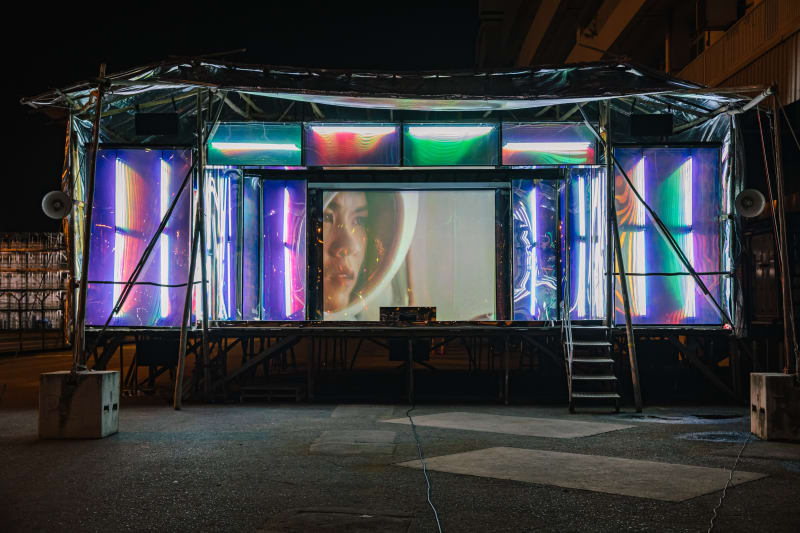Cosmic Theatre: Ming Wong
Ota Fine Arts Shanghai is pleased to present Cosmic Theatre, a solo exhibition by Singapore-born, Berlin-based artist Ming Wong. This marks the artist’s first solo exhibition in Shanghai and his third solo exhibition with Ota Fine Arts, following his Singapore and Tokyo presentations. Wong is known for his interdisciplinary practice incorporating performance, video, installation and photography, taking inspiration from world cinema, music, television, the history of Chinese opera on stage and screen, and notions of futurity and science fiction. In many of his works, Wong plays all of the characters, challenging his viewers to reimagine societal structures, identities and gender, and pushing the possibilities of cinematic language. Local audiences may recall his memorable solo presentation Ming Wong: Next Year, at the Ullens Centre of Contemporary Art (UCCA), Beijing in 2015.
The video work in this exhibition was first exhibited in ‘Wayang Spaceship’, a large-scale outdoor installation commissioned by the Singapore Art Museum in 2022. Here, “wayang” refers to Chinese street opera in Singapore, which is performed on a makeshift wooden stage. Next to a container port that hints at Singapore’s history of development through trade and immigration, Wong had set up a Wayang stage made with mirror-reflective materials. The video work that merged Cantonese opera footage with science fiction films from the 1950s to the 1970s was the centrepiece of a scenographic installation in which a “scholar warrior” - Wong's alter ego - embarks on a journey in the ‘Wayang Spaceship’ through time, space and gender, to a hybrid soundtrack of “Cantonese opera science fiction cinema”, framed by flickering rainbow-coloured fluorescent lights. For Ota Fine Arts Shanghai, the artist will transform the facade of the gallery into a portal of rainbow lights to guide viewers to enter into the world of the ‘Wayang Spaceship'.
In the gallery, viewers are introduced to a speculative dimension populated by the heroes and players of Wayang, through a photomontage series. From a collection of found photographs of Hokkien, Teochew and Cantonese Wayang actors, the artist Wong has selected a cast of gender-bender-scholar-warriors, transported to futuristic scenographies repurposed from Soviet science fiction magazines from the same period, embellished with layers of ink wash paintings and fragments of dichroic films. The collages are then re-photographed to achieve the special colour effects, as if ‘painted with light’, as a result of the flash light reflecting off the dichroic films at different angles.
The magnified compositions take the viewer on visual expeditions that recall images from Stanley Kubrick´s 2001: A Space Odyssey (1968) as well as Andrei Tarkovsky’s Solaris (1972), specifically in the depiction of otherworldly environments and dimensions, except that here, an alternative perspective on Cold War cultural contention is proposed. The space-time-travelling wayang actors take centre stage, asserting their position at the intersection of tradition, technology and gender of a multidimensional, diasporic, futurist opera.
Elsewhere, the photographs of Astro Girl can be found, shot on location together with the video work, “Windows On The World (Part 1)”, which was commissioned by Para Site, Hong Kong in 2014. The setting is derived from Tarkovsky’s film Solaris (1972), with the artist moving slowly through the spaceship to the soundtrack of a Cantonese opera aria Wang Zhaojun’s Exile to the Barbarians (1956).
Acknowledging the artist’s roots in Singapore and China, the photomontage series and the ‘Wayang Spaceship’ could be seen as a multi-layered re-evocation of ‘Nanyang style’, connecting past and future in a non-linear construction of time. As a student at the Nanyang Academy of Fine Art department of Chinese Painting in the 1990s, Wong started to research and document the backstage world of traditional Chinese street theatre, culminating in Wayang Sayang, his first solo exhibition in Singapore in 1995 at the Substation. Wayang Sayang was also the title of an award-winning short play written by the artist and produced at Jubilee Hall in 1993, about an ageing wayang actress reflecting on the struggles of her life and art. Wong moved to London and studied at the Slade School of Art, and subsequently to Berlin, building a body of work that features multiple role-playing in world cinema, often by the artist himself, to explore the constructions of identity through performance, language, race, gender and nationality. In 2009, he won a Special Mention at the 53rd Venice Biennale (2009) for his solo presentation at the Singapore Pavilion, Life of Imitation. From 2010 onwards, Wong started travelling regularly to Hong Kong and Southern China, fueling his interest in the history of Cantonese opera cinema, and discovering the transnational connections between diasporic Southern Chinese identity and the history of cinema in China and Hollywood.
Wong’s work “Scenography for a Shanghai Science Fiction Opera” will also be on display as part of the multifaceted ongoing project AUUUUDITORIUM at the Rockbund Art Museum, Shanghai.



